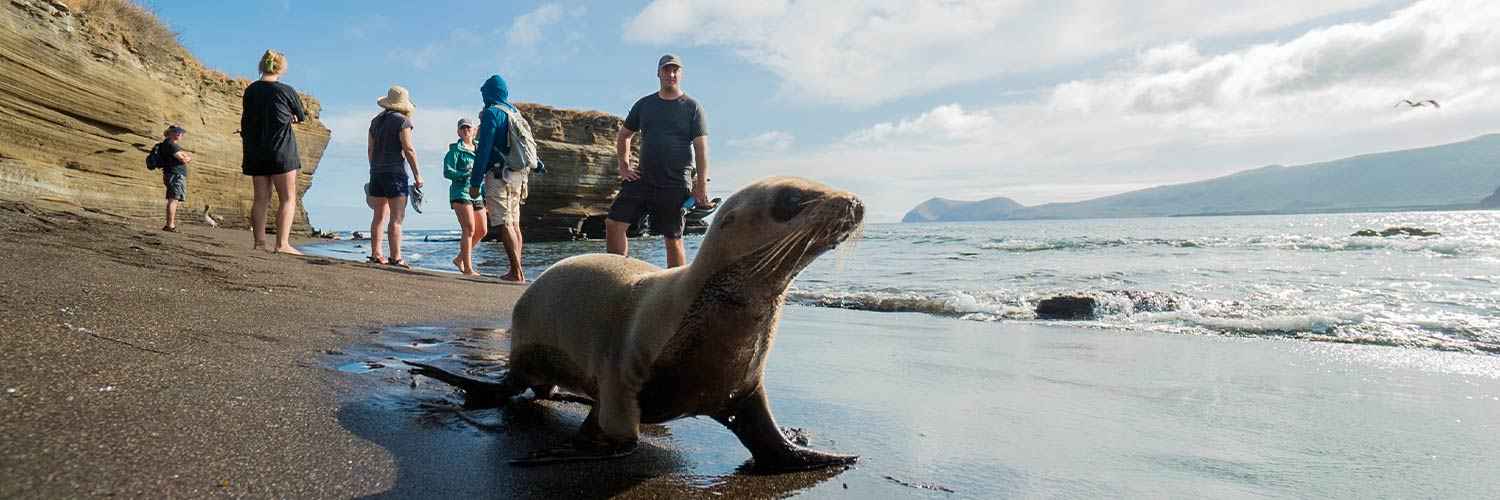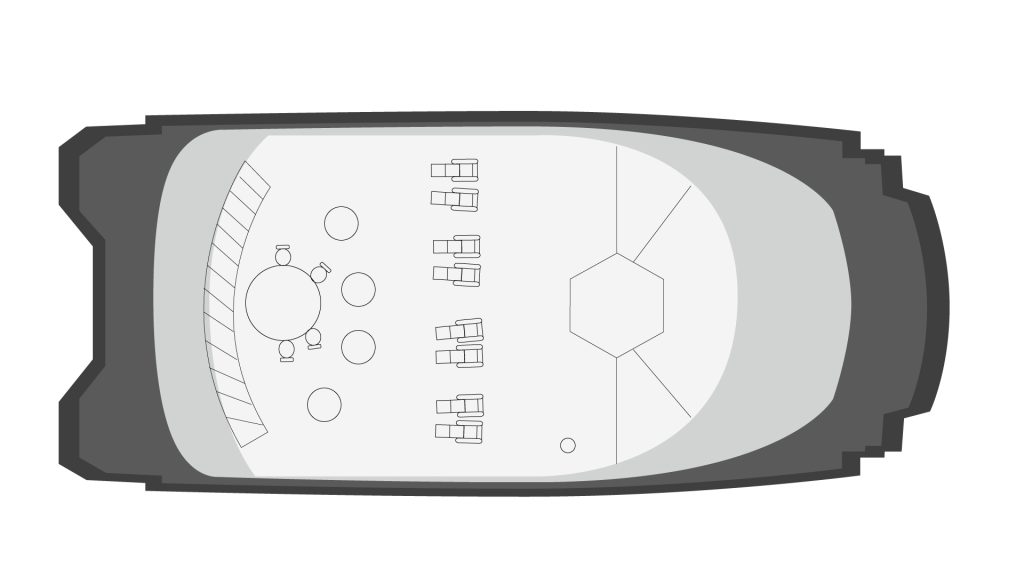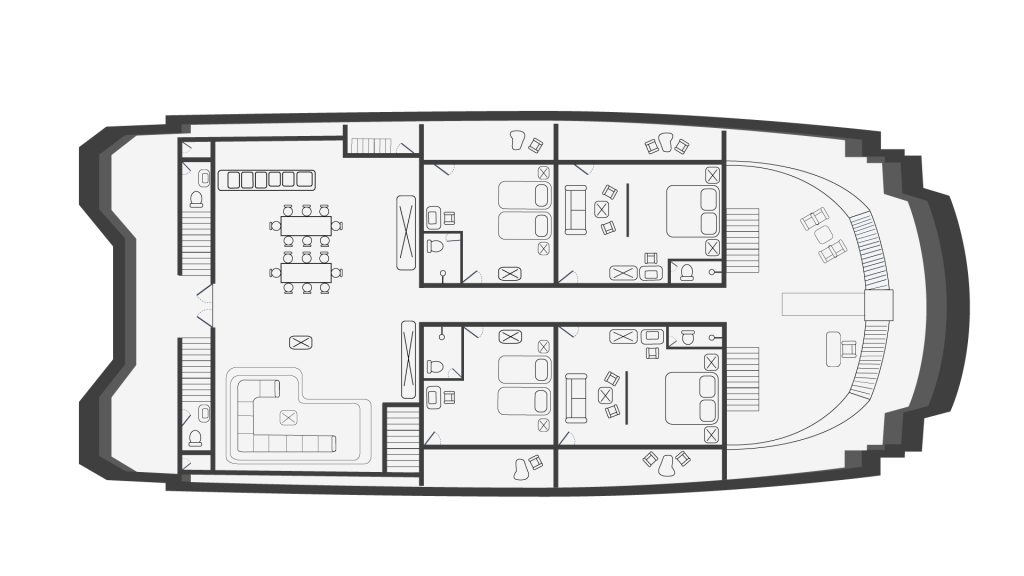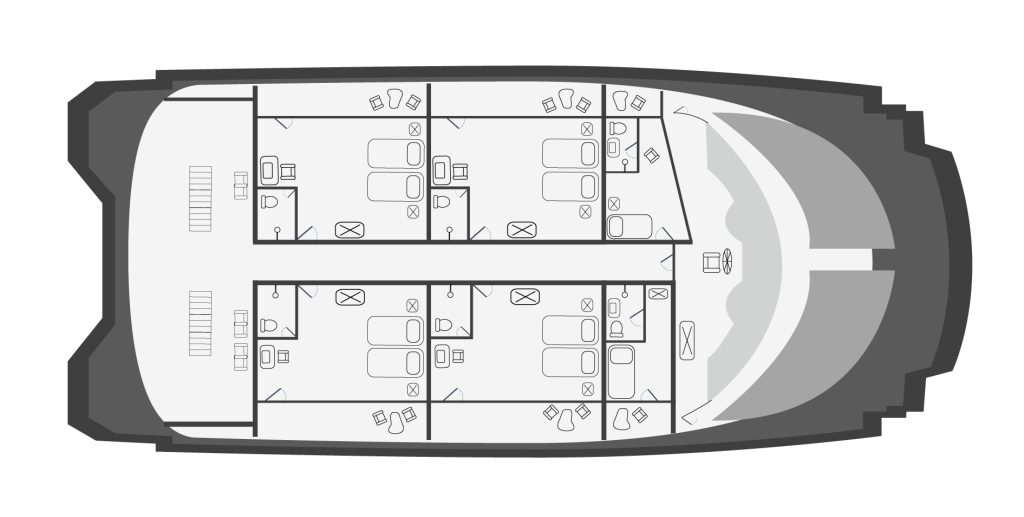Petrel
The Petrel is sleek, redesigned and one the best options for enjoying the Galapagos Islands in style. The 16-passenger Petrel was conceived for comfort and stability, offering plenty of space per guest onboard with high-end facilities and amenities. Features include a welcoming briefing area for enriching lectures and talks given by dedicated, top-ranked Naturalist Guides.
The Petrel has panoramic ocean views from all suites, thanks to its wall-to-wall and floor-to-ceiling sliding glass doors. A luxurious private area where our guests can unwind and enjoy the islands while navigating will be available, and all suites will feature premium biodegradable amenities, deluxe bed linens and natural lighting.
Breakfast, lunch and dinner are served al-fresco in the sky deck lounge or in the indoor dining room. On the sky deck, guests can enjoy the sunbathing platform, next-generation whirlpool, comfortable daybeds, outside bar and al-fresco dining area from the best location on the ship. Guests can also enjoy the vessel’s sun terraces and observation platform for spotting wildlife from on board the Petrel.
The passengers’ lounge and social areas are spacious, and there is also a complete library available for reading about both the Galapagos and Ecuador in general. All excursions are guided by top-ranked naturalist guides offering unique moments with the endemic Galapagos wildlife while out on excursions. Our guides are passionate and knowledgeable about the islands’ animals and the geography of the archipelago. Two daily excursions will be part of your activities. Each guided excursion features walks, kayaking, snorkeling, paddle boarding, dinghy rides, wildlife observation and many more surprises.
M/C PETREL Itinerary A 7-Night Cruise Friday – Friday ISABELA, FERNANDINA & CENTRAL ISLANDS DAY BY DAY ITINERARY DESCRIPTION (B: breakfast/ L: lunch/ D: dinner)
Day 1: Friday AM: Arrival to Baltra Island Assistance will be provided upon your arrival by a Petrel representative after passing through immigration and baggage claim. When ready, you will be transferred to the yacht. You will then be shown to your cabin where you will have some time to settle in before the welcome briefing and lunch. PM: North Seymour Island The island was named after English nobleman Lord Hugh Seymour. Formed by uplifted submarine lava, the island is home to a huge colony of about 2,500 land iguanas and large populations of sea lions, blue-footed boobies, common noddies and frigatebirds. Along the coast it is possible to see land and marine iguanas and the biggest colony of Magnificent Frigatebirds. Possible Activities: Snorkeling, dinghy ride, hike Difficulty: Moderate/Difficult Type of Landing: Dry Landing Highlights: Land and marine iguanas, frigate birds, Blue-footed Boobies, common noddies, and sea lions. Snorkelling: Rays, reef shark, fish, and garden eels. ( -, L, D)
Day 2: Saturday AM: Isabela Island – Vicente Roca Point Isabela Island: This is the largest of all the Galapagos Islands, about 120 km long, and is peculiarly shaped like a sea-horse! It is one of the few islands that are populated. The last census that was taken estimated about 2,200 people living on the Southern part of the Island. The island was formed by 6 different shield volcanoes from North to South that erupted continuously, eventually joining together to form on entire land mass. Of all the islands in the archipelago, Isabela is the most active with the latest eruption coming from Wolf Volcano in May of 2015. There are lots of unique wildlife on Isabela such as the pink iguana, and more wild tortoises than any other island with a different type of species near each of the 6 volcanoes. On Vicente Roca Point the geological formations are simply outstanding and it is a great place to view various bird species such as blue-footed boobies, Nazca boobies, gulls, storm petrels, and brown noddy terns. Activities here are all done on the water by either dinghy or panga, or snorkeling. On this western part of the island the Cromwell Current provides cold water and many nutrients. Due to this it is possible to see various feeding frenzies of an assortment of animals such as whales, dolphins, sea lions, and marine birds diving. At times it may also be likely to see fur seals. Possible Activities: Snorkeling and dinghy ride Difficulty: Easy/Moderate Type of Landing: No landing Highlights: Blue-footed boobies, Nazca boobies, sea lions, fur seals, whales. Snorkel - various tropical fish, sea turtles and other marine animals. PM: Fernandina Island – Espinosa Point No foreign species have ever invaded Fernandina Island and therefore it is one of the world’s most pristine island ecosystems. It is one of the most active islands and is the westernmost island in the archipelago. The volcano “La Cumbre” dominates the landscape with lava fields reaching the ocean. The Cromwell Current also flows on the west making the cold and nutrient rich water an ideal habitat for the Galapagos Penguin and Flightless Cormorant that nests here. Espinosa Point area on Fernandina also provides a great opportunity to see the Galapagos Hawk. Land iguanas are found on the inner parts of the island near the volcanoes caldera and marine iguanas will nest on the coast during certain times of the year. There is only one visitor site to Fernandina which may involve a hike or snorkelling opportunity, making the rest of the island unspoiled in a most natural state. Possible Activities: Hike and Snorkel Difficulty: Easy/Moderate Type of Landing: Dry/Slippery Highlights: Flightless cormorant, Active Volcano “La Cumbre”, various types of impressive lava formations, AA lava, Marine Iguanas, occasional land iguanas, Galapagos penguins, sea lions and sally light foot crabs. Snorkel – marine iguanas, colorful species of fish, eagle rays, sea turtles (B, L, D)
Day 3: Sunday AM: Isabela Island – Tagus Cove This visitor site is located on the upper west part of the island and was named after and English war ship that used to pass the islands in the 1800’s. This was a famous spot for many pirates and sailors who have even left their names and the names of the ship inscribed on volcanic rock. There are many different characteristics of the island here from various volcanic activities such as large volcanic rocks or small little balls of petrified rain. On the hike the path leads to Darwin Lake with a tuff cone. Possible Activities: Hike, Kayaking, Dinghy Ride and Snorkel Difficulty: Easy/Moderate Type of Landing: Dry Highlights: Galapagos penguins, flightless cormorant, finches, land iguanas, large-billed flycatchers, hawks, land birds and remnants of past pirates and sailors. Snorkel – Galapagos penguins, various species of fish, sea turtles. PM: Isabela Island – Urbina Bay A bit more south of Tagus Cove is Urbina Bay. Urbina Bay is an interesting site due to the uplifts of the island caused by volcanic and tectonic activity. When it rose, so did the corals and reefs that were under the surface. You can still see them although they are beginning to deteriorate due to air exposure. There are chances of seeing giant tortoises, land iguanas, and more flightless cormorants near the coast. (B, L, D)
Day 4: Monday - Possible Activities: Hiking and snorkel Difficulty: Easy/Moderate Type of Landing: Wet Highlights: Exposed coral reef, giant tortoises, Galapagos hawk, land iguanas, flightless cormorants. Snorkel – green sea turtles, larger fish, Galapagos penguins. Monday AM: Isabela Island – Elizabeth Bay A visitor site on the way down to the southern parts of Isabela Island is Elizabeth Bay. There are a series of islets, a lagoon and mangroves surrounding it. The mangroves provide a great place to observe many birds and at the lagoon it is possible to see sea turtles resting and feeding. Possible Activities: Dinghy ride Difficulty: Easy/Moderate Type of Landing: No Landing Highlights: Sea turtles, red and black mangroves, lava herons, Galapagos penguins, rays, flightless cormorants. PM: Isabela Island – Moreno Point On the South Western point of Isabela Island is Moreno Point. With striking black geological features, it is home to endemic species known only to the barren lava flows found here. Various activities are possible such as a hike, a panga ride to better see various sea birds, geological features, and snorkeling to view the vibrant underwater life. Possible Activities: Dinghy ride, Hike and Snorkeling Difficulty: Moderate/Difficult Type of Landing: Dry Landing Highlights: Common gallinules, flamingos, paint-billed crakes, white-cheeked pintails, sea turtles, white-tipped reef sharks, pintail ducks. Snorkeling – assortment of fish, sea lions, green sea turtles, sharks. (B, L, D)
Day 5; Tuesday AM: Isabela Island – Sierra Negra Volcano Sierra Negra is located on the South of the Island and are two of the oldest of all Isabela’s volcanoes. A hike will show different types of vegetation and geological zones and possibly inside the caldera where petrified lava is present. Possible Activities: Hike Difficulty: Moderate/Difficult Type of Landing: Dry Landing Highlights: Various types of vegetation, geological zones, Volcano Chico and Sierra Negro – oldest volcanoes of Isabela Island, panoramic views. PM: Isabela Island – Arnaldo Tupiza Breeding Center + Wetlands The Arnaldo Tupiza Breeding Center, where two species of giant tortoise are bred to increase the population of these incredible animals, plays an essential role in protecting the future of the Galapagos. As you walk around the Centre you will also be able to enjoy the beautiful gardens that boast of a wide variety of native plants. Just outside Puerto Villamil you can also take a walk around the Isabela wetlands, comprised of lagoons, swamps and mangroves, which have become a paradise for migratory birds such as stilts and flamingos. Possible Activities: Hike Difficulty: Moderate Type of Landing: Dry Landing Highlights: Various vegetation on hike, flamingo, oystercatchers, ghost crabs, green turtle nesting site, Galapagos penguin. (B, L, D)
Day 6: Wednesday AM: Santa Cruz Island – Charles Darwin Research Station Today Santa Cruz is one of the most popular tourist sites. With a population of about 12,000 Galapagos natives, it has the longest paved road in the entire archipelago. One of the biggest conservation efforts is to eliminate all non-native plants and animals that are destroying native and endemic species on the island. There is no longer any volcanic activity but that does not mean there is no evidence. Santa Cruz means holy cross, but its English name comes from the British vessel – Indefatigable. Charles Darwin Research Station conducts many different research projects and provides assistance to other researchers and governmental institutions and agencies, especially the Galapagos National Park. Many of the results are later published online, in magazines, and popular scientific journals. The research station also plays a big part in educating the community and public schools in Galapagos. There is also the longtime running Giant Tortoise restoration program that includes various stages of the giant tortoise from eggs, hatchlings and adults. Possible Activities: Hike Difficulty: Easy Type of Landing: Dry Highlights: See the latest advances in research at the Charles Darwin Research Station. Also see Giant Tortoises and land iguanas. PM: Santa Cruz Island – Highlands As part of your day, we will head towards the Highlands of Santa Cruz to visit the Twin Craters or Gemelos, meaning twins in Spanish, are two caved in magma chambers of a previous volcano. After years of erosion and extinction, the once full chambers caved in leaving two similar craters that can be seen on a short hike that passes by a Scalesia forest. Then, be prepared to admire the famous giant tortoises in the wild. It is impressive to see these endemic animals that give the name to the archipelago, Galapagos. Birdwatching is also one of the activities in the highlands, since this area is home of finches and other Galapagos birds. Finally, we walk into lava caves to see the enormous lava flows that formed the islands before continuing back to the M/C Petrel. Possible Activities: Hike Difficulty: Moderate Type of Landing: Dry Landing Highlights: On the trail to the craters many different land birds can be seen in the Scalesia forest – finches, short eared owls, vermilion flycatchers, and Galapagos doves. (B, L, D)
Day 7: Thursday AM: South Plaza Island South Plaza is one of the smallest islands with a visitor site, but is home to an incredible amount of diverse flora and fauna. It has a large population of Sesuvium plants like the prickly pear cactus tree that is an important source of food for the land iguana. Just a few years ago mice were finally eradicated from the island, helping the population of land iguanas grow healthily once more. Possible Activities: Hike Difficulty: Easy Type of Landing: Wet Landing Highlights: Cacti native only to South Plaza, land iguana, finches, sea lions, swallow tailed gulls, red-billed tropicbirds. PM: Santa Fe Island Santa Fe Island is home to the unique Santa Fe land iguana and is the only place to find Opuntia cactus. Giant tortoises were once native to this island but after the many years of pirates and buccaneers visiting the island and taking the tortoises aboard as food, they became extinct. The Island is also called Barrington Island, named after British Admiral Samuel Barrington. Large numbers of sea lions can be found on the landing beach and Galapagos hawks can also sometimes be seen. Possible Activities: Short hike, Dinghy Ride, Kayaking and snorkel Difficulty: Easy Type of Landing: Wet Landing Highlights: Galapagos hawk, Santa Fe land iguana, Opuntia Cactus, sea lions, lava lizards. (B, L, D)
Day 8: Friday AM: Lobos Island San Cristobal Island is the fifth largest island in the Galapagos and lies farthest East. It is where Darwin first landed back in 1835 and where the first permanent settlements were founded. Today the main port Puerto Baquerizo Moreno is the capital of Galapagos and houses many government offices, the Ecuadorian Navy, and an airport with daily flights to the mainland of Ecuador. Conservation challenges the island faces include invasive plants like blackberry and guayaba and insects like the blackfly. Lobos Island is an islet about an hour away from San Cristobal. Blue-footed boobies will nest here seasonally. In recent years frigate birds have begun to nest here. Sea lions are abundant, as well as marine iguanas. It is a very calm and tranquil site with beautiful views, including Kicker Rock off in the distance. Possible Activities: Hike Difficulty: Easy/Moderate Type of Landing: Dry Landing Highlights: Frigate birds, sea lions, blue-footed boobies and nesting sites, views of Kicker Rock, marine iguanas. Snorkel – sea lions, sea turtles, rays. Transfer to San Cristobal Airport Your cruise has officially come to an end. We hope you enjoyed your Galapagos Cruise! We will now transfer you to your scheduled departure from San Cristobal Airport to mainland Ecuador. Safe travels! (B, -, - ) ***End of cruise*** * Itineraries are subject to change without prior notice. Shorter itineraries are also available.
DECK PLANS
Comfort and Safety
The staterooms and social areas aboard the M/C Petrel are distributed across 3 decks, which are described below:
MAIN DECK
The Main Deck hosts both the dining area, with sweeping views of the islands, and the briefing area where daily talks are held about the activities that guests will be able to enjoy the following day. There are also two spacious staterooms and 2 large master suites, each offering over 460 ft2 (43 m2) of space and roomy private balconies. The main deck also hosts a spacious disembarking platform where guests board and disembark from the vessel, and where delicious post-exploration snacks and drinks are served.
UPPER DECK
The Upper Deck hosts 4 premium staterooms, each with large windows and a private balcony, and 1 spacious single cabin for solo travelers. There is also a wildlife observation platform on this deck that is furnished with comfortable sofas where guests can relax and enjoy watching the many species of birds in the Galapagos, and even spot whales, dolphins, sharks and rays in the azure waters surrounding the vessel. The bridge of the M/C Petrel is also on this deck, and guests are always welcome to stop by, speak to the Captain and First Officer, and learn about the cutting-edge navigation technology used aboard the catamaran.
SKY DECK



